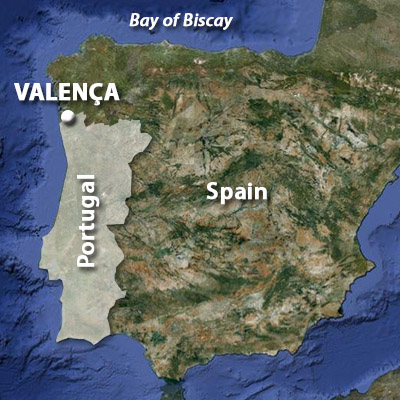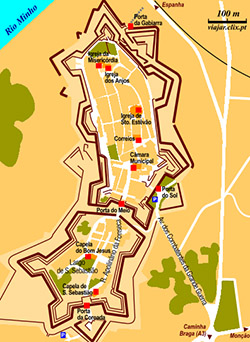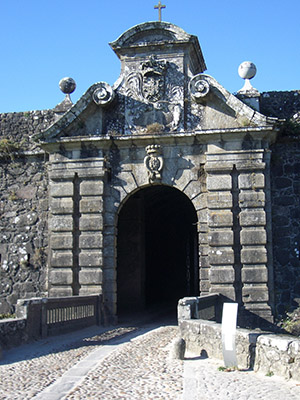 |
Praça-forte de Valença
Valença do Minho, Portugal
|
|
 |
Constructed: 1640-1654, 1661-1713
Used by: Portugal, Spain, France
Conflicts in which it participated:
Portuguese Restoration War,
Peninsular War, Liberal Wars
|
The Minho River flows 210 miles through the northwestern extent of Spain, and marks Spain's border with Portugal for some of that distance. This border has been contentious for literally thousands of years, and today it's difficult to walk in this area without stubbing one's toe on a starfort, or what was once a starfort.
Today's town of Valença came into being because it was at a spot where Romans wished to cross the Minho River while traveling from Brago to Tui, the latter being the town that faces Valença on the Spanish side. This occurred as early as the 2nd century BC. |
 |
 |
|
Once the Romans had gone off to pretend they still had an Empire of the Holy variety, various galloping hordes ranging alphabetically from Arabs to Vikings (too bad the Zulus never made it that far north: That would have been an impressive spread!) had their way with our little Portuguese town on the Minho.
Portuguese King Sancho I (1154-1211) earned the sobriquet The Populator by populating the Christian northern areas of Portugal in the 12th century. This helped to squeeze out the ever-invasive Moors, who had conquered virtually all of the Iberian Peninsula (modern Spain and Portugal) by the 8th century, but were being rolled back to that from whence they came by the Reconquista through the 12th and 13th centuries.
|
Any attacker who hadn't first examined satellite imagery was surely dismayed by |
 |
King Populator named the town that would become Valença Contrasta, meaning "village opposed to another" (that opposing village being Tui across the river), and built the first fortifications there. Whatever those fortifications were, they were not a starfort. Because this was the beginning of the 13th century, when the starfort was no more than the glint in a stonemason's eye.
Portuguese King Afonso III (1210-1279), an enthusiastic proponent of eradicating Moors from his lands (as well he should have been), bestowed the much more pleasant-sounding name of Valença on the town of our current interest in the mid-13th century. |
|
|
In 1580, King Phillip II 1527-1598) of Spain claimed the Portuguese throne. This occurred because Portugal's previous king had died without any heirs, and under this brilliant system of governance it was only logical that Phillip should rule o'er Portugal as well...because he was already a king, after all. Could Zhu Yijun (1563-1620), 13th Emperor of China's Ming Dynasty, have claimed the Portuguese throne had he been keeping an eye on current events on CNN? Absolutely.
|
While Portugal still retained overall independence during the period known as the Iberian Union, its foreign policy was hijacked by Spain. Forced into conflicts that it otherwise may have avoided, Portugal lost many of its valuable overseas holdings to the Dutch and British, including such stellar forts as the Fort of Our Lady of the Conception in the Strait of Hormuz and the Forte dos Reis Magos in Brazil. Portuguese nobles finally rose against their Spanish quasi-overlords in 1640, led by John IV (1604-1656). John became king of Portugal, and was granted the nickname John the Restorer. Did all Portuguese kings have cool nicknames? Yes, although Joseph of the Irritable Bowels didn't really go around bragging about his nickname.
|
 |
I used to refer to garitas as dingleberries. I have since had a garita conversion, accepting and even admiring them as useful additions to the starfort. What am I to think however, when a garita has what can only be described as a dingleberry atop, such as in this case? I think they're just screwing with my head. |
|
Notably, the year of 1640 marked both the start the Portuguese Restoration War (1640-1688) and the start of construction on the starfort of our current interest. A strong fortification was needed at Valença to anchor Portugal's upper left border with Spain, something more substantial than the medieval fort that was currently crumbling into the Minho River: Enter Miguel de l'école.
De l'école (whose name looks awkward because it really seems as though it should have a large É instead of a small é but I am reasonably confident that I'm presenting it correctly: Perhaps I'll feel better about things if I just refer to him as Miguel in the future) was a French military engineer in the employ of Portugal. He had been working on whatever Portuguese fortifications hadn't been lost to the Dutch in Brazil, but was called back to the motherland at the start of the Portuguese Restoration War. Miguel was put in charge of fortifying Valença, which he accomplished by surrounding the entire town with high walls, supported by state-of-the-art starfort bastions!
|
 |
 |
The seven bastions of the main fort were named Carmo, Hope, Faro, Lapa, St. Francis, St. John and Socorro. It was of course important to name each bastion so as to prevent confusion in the heat of battle ("Private José, run over to Lapa, grab some gunpowder and distribute it betwixt St. John and Carmo!"), and naming those bastions "#1" through "#7" would have been ridiculous.Praça-forte de Valença (Stronghold of Valencia)'s separate fortification, to the bottom of the main fort in the map to the left, is a Crownwork. This was a version of a Hornwork, which was designed to extend a fort's defensible area without going full fort all the way 'round (see Fort Bellegarde in France for a particularly nasty-looking Hornwork). In this case the Crownwork served to bend the defensive position around a smidge so that much more fortification faced the strategic bridge over the Minho River: Try to unionize us in an Iberian fashion now, Spain!! The Crownwork's three bastions were named Santa Ana, St. Jerome and Santa Barbara, and its two half-bastions (the stubby things closest to the main fort) St. Joseph and St. Anthony. |
|
|
Spain did not take kindly to this Restoration business. In the first years of the Portuguese Restoration War, Spain mostly poked at Portugal's borders and withdrew in indignation upon the discovery that people were actually defending that border. Our praça-forte was still under the early stages of construction when it successfully deflected its first Spanish attack in 1643.
|
Spain got a little more serious about the war as time went on, and their second attempt to capture Praça-forte de Valença, in 1654, proved successful.
Portugal was able to capture it back from Spain in short order, but what with all the excitement they forgot to continue construction, and the fort languished, unfinished, for several more years.
|
 |
|
|
In 1713 the praça-forte was finally pronounced complete by head engineer Manuel Pinto Vilalobos. In 1774 two major additions were made to the fort, the Armory of Gunpowder and the "Armory of Butchery" (armory for producing choice cuts of meat?).
...just in time to be captured by the French! Napoleon (1769-1821), bent on total domination of the world and outer space, sent troops into Spain and Portugal in 1807, initiating what is now known as the Peninsular War (1807-1814). French troops under Marshal Soult (1769-1851) besieged Praça-forte de Valença in 1809. The praça-forte held out "with undaunted resistance" for an indeterminate amount of time, until the Porta do Sol (Sun's Door), the fort's main entrance, was blown up, and the French had themselves a new starfort.
|
 Praça-forte Valença's Porte de Corada (Blushing Door), its southernmost portal. This one was not blown up by the French. Praça-forte Valença's Porte de Corada (Blushing Door), its southernmost portal. This one was not blown up by the French. |
 |
Fortunately the French were prevented from discovering and assembling all five pieces of the Key to Time, with which they could have commanded all time, space, and dimension, and were compelled to leave our praça-forte in 1814.
A mere 14 years later, yet another royal succession crisis pitted "progressive constitutionalists" against "authoritarian absolutists" in Portugal's Liberal Wars (1828-1834). Praça-forte de Valença decided to throw its lot in with the Liberals, which prompted the wicked Royalists to besiege it in 1828 (I have no reason to imagine the Royalists were any more wicked than the Liberals in this conflict, but "Royalists" sure sounds wickeder). The fort's defenders held out for nine days but finally, their supply of veal cutlets from the Armory of Butchery running perilously low, capitulated on the tenth.
The Liberals recaptured the fort in 1830 with the help of Charles Napier (1786-1830), a British Royal Navy officer who had been made Admiral of the Liberal Fleet for the purposes of this fracas. The war ended in 1834 with the Liberals victorious and constitutional monarchy restored. Thank goodness.
|
|
|
By 1867, Portugal and Spain were good enough buddies to build a road-and-railroad bridge at Valença, across which all could come and go freely. A series of conservation and restoration projects were undertaken through the 20th century, which has given the Praça-forte de Valença a beautiful, healthy sheen. Today it is open to the public.
|
|
|
|
|
|
 |




